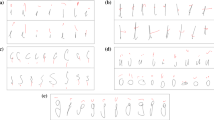Abstract
In modern and medieval manuscripts, a frequent phenomenon is additions or corrections that are marginal or interlinear with regard to the main text-blocks. With the recent success of Long-Short-Term-Memory Neural Networks (LSTM) in Handwritten-Text-Recognition (HTR) systems, many have chosen lines as the primary structural unit. Due to this approach, establishing the reading order for such additions becomes a non-trivial problem, because they must be inserted between words inside line-units at undefined locations. Even a perfect reading order detection system ordering all lines of a text in the correct order would not be able to deal with inline insertions. The present paper proposes to include markers for the insertion points in the recognition training process, those indicators can then teach the recognition models themselves to detect scribal insertion markers for marginal or interlinear additions.
Access this chapter
Tax calculation will be finalised at checkout
Purchases are for personal use only
Similar content being viewed by others
Notes
- 1.
While Poetic texts can be written stichographically with half verses appearing as if written in columns, we assume that lines in Poetic texts are correctly detected if they cover a complete such line connecting both ‘columns’.
References
Clausner, C., Pletschacher, S., Antonacopoulos, A.: The significance of reading order in document recognition and its evaluation. In: 12th International Conference on Document Analysis and Recognition (ICDAR), Washington DC, 2013, pp. 688–692, IEEE (2013)
Quirós, L., Vidal, E.: Learning to sort handwritten text lines in reading order through estimated binary order relations. In: 25th International Conference on Pattern Recognition, ICPR 2020, Virtual Event/Milan, Italy, January 10–15, 2021, pp. 7661–7668, IEEE (2020)
Prasad, A., Déjean, H., Meunier, J.-L.: Versatile layout understanding via conjugate graph. In: 15th International Conference on Document Analysis and Recognition, (ICDAR) Sydney, Australia, September 20–25, 2019, pp. 287–294, IEEE (2019)
Malerba, D., Ceci, M., Berardi, M.: Machine learning for reading order detection in document image understanding. In: Marinai, S., Fujisawa, H. (eds.), Machine Learning in Document Analysis and Recognition, Studies in Computational Intelligence, vol. 90, pp. 45–69, Springer, Berlin (2008). https://doi.org/10.1007/978-3-540-76280-5_3
Ferilli, S., Pazienza, A.: An Abstract Argumentation-based strategy for reading order detection. In: Proceedings of 1st AI*IA Workshop on Intelligent Techniques At Libraries and Archives colocated with XIV Conference of the Italian Association for Artificial Intelligence, IT@LIA@AI*IA 2015, Ferrara, Italy, September 22, 2015, CEUR Workshop Proceedings 1509, http://ceur-ws.org/Vol-1509/ITALIA2015\(\_\)paper\(\_\)1.pdf
Kovanen, S., Aizawa, K.: A layered method for determining manga text bubble reading order. In: 2015 IEEE International Conference on Image Processing (ICIP), Quebec City, QC, 2015, pp. 4283–4287. https://doi.org/10.1109/ICIP.2015.7351614
Stökl Ben Ezra, D., Brown-DeVost, B., Dershowitz, N., Pechorin, A., Kiessling, B.: Transcription alignment for highly fragmentary historical manuscripts: the dead sea scrolls. In: 17th International Conference on Frontiers and Handwriting Recognition (ICFHR), Dortmund (2020), pp. 361–366, IEEE (2020)
Kiessling, B., Tissot, R., Stökl Ben Ezra, D., Stokes, P.: eScriptorium: an open source platform for historical document analysis, In: Open Software Technologies (OST@ICDAR) 2019, pp. 19–24, IEEE (2019)
Stokes, P., Kiessling, B., Tissot, R., Stökl Ben Ezra, D.: EScripta: a new digital platform for the study of historical texts and writing. In: Digital Humanities, Utrecht 2019 (DH 2019)
Kiessling, B.: Kraken – a universal text recognizer for the humanities. In: Digital Humanities, Utrecht 2019 (DH 2019)
Kiessling, B., Stökl Ben Ezra, D., Miller M.: BADAM: a public dataset for baseline detection in arabic-script manuscripts. In: HIP@ICDAR 2019, Sydney (2019), pp. 13–18, ACM (2019)
Kiessling, B.: A modular region and text line layout analysis system. In: 17th International Conference on Frontiers in Handwriting Recognition (ICFHR), Dortmund (2020), pp. 313–318, IEEE (2020)
Acknowledgments
Images from manuscript Kaufmann A50 of the Library of the Hungarian Academy of the Sciences, Budapest, by permission CC-BY-NC-SA.
Author information
Authors and Affiliations
Corresponding author
Editor information
Editors and Affiliations
Rights and permissions
Copyright information
© 2021 Springer Nature Switzerland AG
About this paper
Cite this paper
Stökl Ben Ezra, D., Brown-DeVost, B., Jablonski, P. (2021). Exploiting Insertion Symbols for Marginal Additions in the Recognition Process to Establish Reading Order. In: Barney Smith, E.H., Pal, U. (eds) Document Analysis and Recognition – ICDAR 2021 Workshops. ICDAR 2021. Lecture Notes in Computer Science(), vol 12917. Springer, Cham. https://doi.org/10.1007/978-3-030-86159-9_22
Download citation
DOI: https://doi.org/10.1007/978-3-030-86159-9_22
Published:
Publisher Name: Springer, Cham
Print ISBN: 978-3-030-86158-2
Online ISBN: 978-3-030-86159-9
eBook Packages: Computer ScienceComputer Science (R0)





